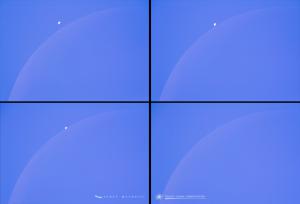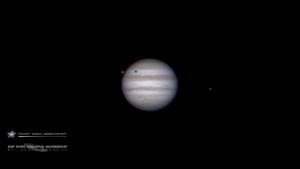
Stargazing Nights
- Where:
- Frosty Drew Observatory
- When:
- Friday March 3, 2017 at 6:00 p.m
- Cost:
- $1 Suggested Donation per Person
Tonight is Stargazing Night at Frosty Drew Observatory and the forecast is calling for partly cloudy skies and periodic flurries to start, with clouds moving out after 9:00 p.m. We can also expect sustained winds upwards of 12 mph with gusts reaching into the 29 mph range. Gusts that intense are a bit over our acceptable threshold and may restrict viewing to one side of the sky. The 30% waxing gibbous Moon will be with us at sunset hanging beautifully in the western sky and will set around 11:30 p.m. Though clouds may be annoying earlier in the night, there should be enough clearings to catch a view of Venus and the crescent Moon if winds allow.
We will open the Observatory and Sky Theatre at 6:00 tonight. In the Observatory, telescopes will start off on Venus and the 30% crescent Moon if wind conditions allow us to orientate the dome in that direction. If clouds are heavy, we will do our best to grab a view of the brighter objects. Once clouds move out we will rock the night sky with views of the Orion Nebula, star clusters, and possibly galaxies later. Jupiter will become accessible to our telescope around 9:30 p.m., just in time to catch Io, the smallest Galilean Moon, casting its shadow on Jupiter’s atmosphere. In the Sky Theatre we will feature warm temps and celestial objects that we have photographed at Frosty Drew Observatory. We will stay open until near midnight tonight, with the potential to stay much later if weather works out.
Overall, tonight could be a fantastic night under the stars. The Moon is in an excellent phase for viewing, and will not overly out-shine dimmer objects. The second half of the night will bring super dark skies after the Moon departs. Clouds can be a bit problematic to start, though they should clear early in the night. The big deal tonight will be the super cold temps and the wind. Temps will drop into the teens before sunrise and wind chills will be much colder. Dressing for extreme winter conditions is a requirement tonight as frostbite can set in fast! Read about properly dressing for extreme winter conditions. Following us on Twitter (@FrostyDrewOBSY) and Facebook will get you updates on the conditions we are seeing at the Observatory as the night progresses, as well as a “Closing up” post when we decide to pack it in. So bundle up, grab a warm cup of something awesome and spite the cold with a fabulous night out under the stars at Frosty Drew Observatory tonight.
------------------
Weekly Happenings
Scott MacNeill
Saturday night, March 4th, between 11:00 – 11:30 p.m. the Moon will pass in between our view of the bright star Aldebaran. This is called the occultation of Aldebaran. It takes 27.3 days for The Moon to complete one orbit around the Earth, which it does 5° inclined to the Ecliptic, which is the path the Sun takes across the sky and represents the plane of the Solar System. There are a few bright stars in our night sky that are found within 5° of the Ecliptic, which allow for periodic encounters with the Moon visually. Aside from Aldebaran, which is in the constellation Taurus; Antares in Scorpius, Regulus in Leo, Spica in Virgo, and Zubenelgenubi in Libra will all offer up occultation opportunities. Tomorrow’s occultation, though visible over most of the United States, will be barely visible in Rhode Island, happening very briefly just before the Moon sets. To view the occultation, you will need to arrive at a location with a good view of the western horizon before 10:45 p.m. Naked eye viewing will be difficult, so grab some binoculars or a small telescope to catch a view. The very top edge of the Moon will appear to overtake Aldebaran from left to right in your view for about 10 minutes, after which Aldebaran will re-appear. If you catch a photo of the occultation, post it on the Frosty Drew Observatory Facebook page and we’ll share it on our time-line. We should have clear skies tomorrow night, so get out and rock the night!
Later tonight, when Jupiter comes into view of our telescopes, a small black dot will be visible moving slowly across Jupiter’s atmosphere. This black dot is the shadow of Jupiter’s moon, Io. As we move into our viewing season of Jupiter, sightings of the Galilean Moons casting their shadows on Jupiter’s cloud tops will become quite regular. These events are called “Shadow Transits”, which are solar eclipses happening on Jupiter. Being that Jupiter is tilted a mere 3.1° on its axis (compared to Earth’s 23.4° tilt) three of the four Galilean Moons (Io, Europa, and Ganymede) arrive in an eclipse position every time they orbit the daytime side of Jupiter. Being that the three closest Galilean Moons have a stable 1:2:4 orbital resonance, meaning that for every one orbit of Ganymede, Europa will complete two orbits and Io will complete four orbits, more than one eclipse can happen at the same time. This will allow more than one shadow to appear on Jupiter’s cloud tops occasionally. Because of the stable resonance of those three Galilean Moons, all three will not arrive at an eclipse position at the same time. As a result, triple shadow transit require the fourth Galilean Moon, Callisto, which doesn’t share in the orbital resonance. Though Callisto, being the furthest of the four Galilean Moons from Jupiter, is far enough out that it does not arrive at an eclipse position on every orbit. This significantly decreases the frequency of triple shadow transits. Double shadow transits visible from North America this year will occur on May 18, May 26, June 3, and June 19. Tonight will be our first shadow transit at Frosty Drew for the 2017 viewing season, though we will have frequent sightings over the next several months!
-Scott


